Olympia Fields CC (North Course)
by Terry Lavin

One of golf’s greatest two shotters – the 14th on the North Course at Olympia Fields.
Olympia Fields CC, located about 28 miles south of downtown Chicago, has been a home to Championship Golf since the 1920’s. In its 86 years of existence, OFCC has hosted the PGA, the Western Open, the U.S. Senior Open and the U.S. Open. It is the site of the upcoming 2003 U.S. Open, having last hosted the Open Championship in 1925, when Johnny Farrell beat Bobby Jones in a playoff.
When first conceived, Olympia Fields was a 72 hole facility. The first three courses were laid out by Scotsman Tom Bendelow. The #4 Course, now the North Course, was designed by Willie Park, Jr. After the Great Depression, several hundred acres were sold and an 18 hole course was crafted from the 54 hole layout by Bendelow. This is now known as the South Course. The mammoth, original clubhouse, with its famous tudor clocktower, is still intact.
NORTH COURSE:
OVERALL DESCRIPTION: The North Course, after several reworkings, is now a 7157 yard, par 70 routing over a widely varied piece of Midwestern topography. Several of the holes traverse old farmland, but the strongest holes loop around several ridges that also feature a serpentine creek that comes into play. The bunkers were redone a couple years ago and they now are quite penal indeed. Mark Mungeam of Boston did the renovation work and his stamp is all over the redesigned Olympia Fields.
Note: The U.S.G.A has, for crowd control purposes, ‘flipped the nines’, so the pros will be playing the front nine as the back and vice versa. The following is a hole-by-hole description of the course as played currently.
#1: 580-yard par 5. This is a relatively benign starting hole, with the definite exception of the five fairway bunkers. This hole plays downwind and will give a good player a shot at an eagle or a birdie. Keep out of the right greenside bunker. It is truly a pit of despair!
#2: 471-yard par 4. An excellent long par-4 with a left to right dogleg. A set of right side fairway bunkers present a daunting sight from the tee. The green is very deep, with a large grove of trees lurking behind. Well placed pins will make birdie a hard-to-find species here.
#3: 461 yard par-4. This is one of the best par 4’s you’ll ever play. The tee shot carries over a large hill to a narrow fairway and leaves a good player with a long iron shot over a creek to an elevated, well-bunkered green. This is a gem of a hole and it is in substantially the same condition as laid out in the 1920’s (with the exception of the back tee boxes).
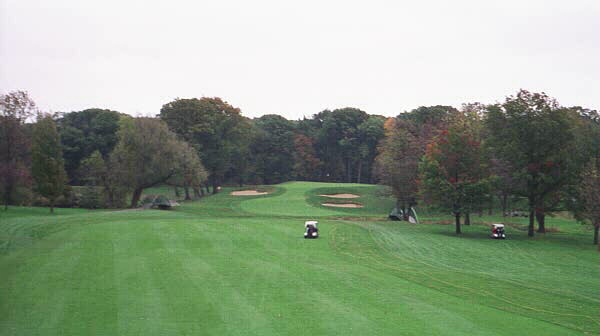
After a blind drive over a hill, the golfer is faced with a long approach to an elevated green that is well defended.
#4: 400 yard par-4. A narrow, oak-tree lined short hole with a huge diagonal swale cutting across the fairway about 240 yards from the tee. The second shot is usually relatively ‘blind’ unless you carry the swale. The green is hard, fast and undulating.
#5: 417 yard par-4. Another narrow hole, this one requiring a precision tee shot through a tunnel of oak trees to an exceptionally tight and well bunkered fairway. The green has a large hogback on the left side and its relative lack of depth makes it very difficult to hit with anything longer than a 7 iron. The right greenside bunker is to be avoided.
#6: 187 yard par-3: An elevated tee shot to a large green with some difficult pin positions. This hole is a total redesign from about ten years ago.
#7: 430 yard par-4. The pros will play this hole from the back of the 15th tee, but it is a handful from the existing back tee. The elevated tee shot must thread the needle between a reachable set of fairway bunkers. The second shot may look simple, but this green is huge with an assortment of difficult pin placements.
#8: 247 yard par-3: Yes, you read that correctly. The U.S.G.A. apparently wants the big boys to use a 3-wood on what will be the 17th hole of the 2003 U.S. Open. For the rest of us, this hole is sheer torture. Even from the regular, blue tee, you have 229 yards, slightly uphill, into the prevailing wind to a subtly undulating green. Take your par and head to the next tee!
#9: 445 yard par-4. A stern test of golf on any day, but particularly when one is into the wind. Most days on the summer, the fan is pointed directly at you. The three fairway bunkers will catch your misdirected tee shot and the green will make you pray for a two putt. This might be the most difficult green on the golf course.
#10: 444yard par-4. A right to left dogleg with bunkers on both sides of the fairway. The second shot is slightly uphill but downwind, to a severely tilted back to front green.
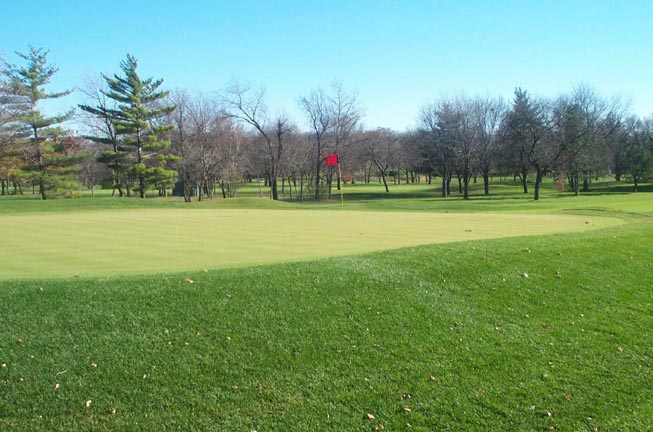
#11: 402 yard par-4. Another slight right to left dogleg with a dicey second shot to a hard, fast and difficult green. Stay out of the bunkers and you’ll have a shot at birdie.
#12: 389 yard par-4. The golf course assumes its most dominant physical character beginning on this tee box. The little corner of creek just off the tee re-introduces the golfer to Butterfield Creek which will reappear about 270 yards later. Aim slightly to the right of the fairway bunker and you’ll have a medium iron to the green which is built into a hillside amphitheater (sort of a mini version of the 18th at Riviera). Take your four and sprint to the next tee!
#13: 168 yard par-3. A delightfully deceptive uphill par three with some imposing front bunkering. There is a demonic hazard waiting to catch any pulled tee shots and a unique sloping green that will make birdie a difficult task.
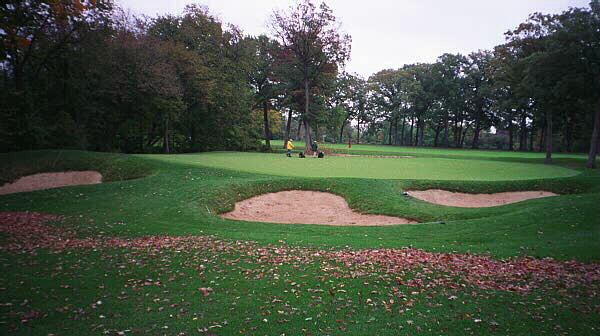
Willie Park Jr. brilliantly laid the one shot 13th across the top of a ridge. A slight pull left of the green and the golfer’s ball could finish some 25 feet below the putting surface.
#14: 444 yard par-4. Get your camera. This hole was laid out more by the deity than by Willie Park, but he had the vision to craft this huge par four out of this unique piece of real estate. The creek wends across the fairway about 125 yards out then takes a left turn and comprises the end of the right side of the rough until it reappears 300 yards from the tee. The creek makes another appearance left of the green, waiting to grab a pull-hook. The second shot is another beauty and the green is a classic back-to-front canted beast. This description does no justice to the elevations of the shots, but suffice it to say that it will take a while for your tee shot to fall to the fairway and your second shot will seem like a heroic feat. Golf at its best.
#15: 576 yard par-5. A lovely monster that wraps around the hazard that you just saw on 14. Stay left, young man, and you’ll be okay. The fairway takes a dramatic turn to the right about 340 yards from the tee box, so we’ll probably see some of the big hitters try to hit this green in two, but there are some definite risks involved, principally in the form of the right hazard and the left fairway bunker.
#16: 215 yard par-3. This hole has been lengthened and ‘opened up’. The tee shot is from an elevated perch, looking down at the smallish green which is penned in by the creek which runs in front of and to the right of the green. Tough birdie.
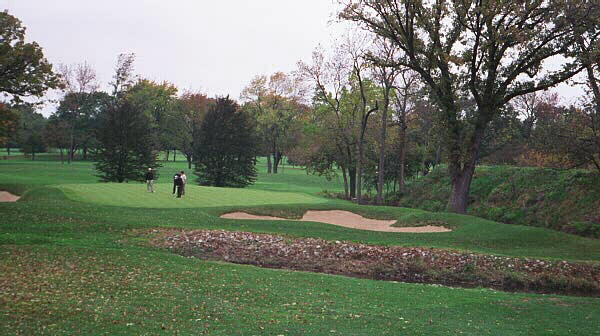
The golfer hits down on the 16th green from a well elevated tee. A stream both cuts across the front and runs along the right side of the green.
#17: 433 yard par-4. This used to be a 375 yard cupcake, but Mungeam moved the tee box across the club driveway and cut down nearly one hundred trees to open up the view of the hole. The creek runs down the right side of the fairway in the landing area. The second shot is to an elevated green that runs away from the golfer.
#18: 468 yard par-4. All I can say is ‘damn the U.S.G.A. for making this the ninth hole of the 2003 U.S. Open! This hole is a natural right-to-left beauty of a dogleg with a pond on the right side that comes into play on your second shot. The green is huge, sloping and full of heroic pin positions. You’ll make many more doubles than pars on this golf hole.
I’ll post a description of the South Course another day, but let me tell you, gentle friend, it is a fabulous golf course.
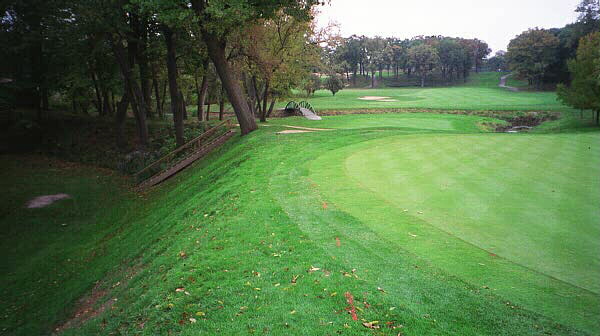
Tom Doak calls the 6th on the South Course ‘a drive-and-death-defying pitch.’ Its green falls sharply away on both sides and behind.
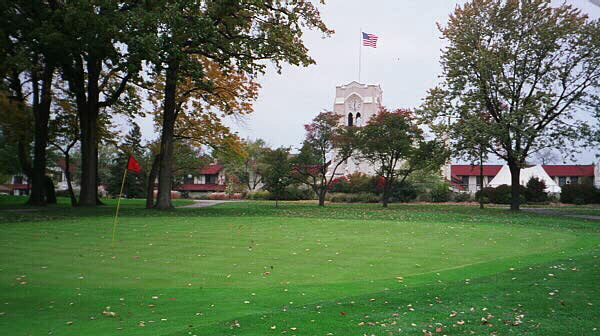
Many of the Tom Bendelow’s most interesting greens on the South Course are extensions of the fairway. Olympia Field’s world famous clubhouse looms in the background.
The End







